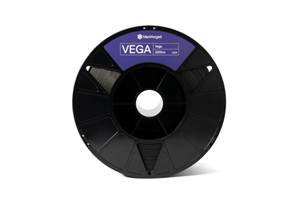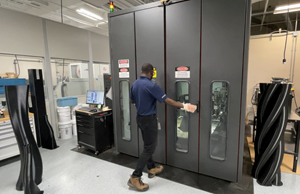SAMPE 2018 keynote looks to the composites future
The SAMPE 2018 general session featured the announcement of the top three papers presented at the conference, and a keynote by Carmelo Lo Faro, president, Solvay Composite Materials (Alpharetta, FA, US).
The SAMPE 2018 general session featured the announcement of the top three papers presented at the conference, and a keynote presented by Carmelo Lo Faro, president, Solvay Composite Materials (Alpharetta, GA, US).
The top three papers were:
- First place: “Fabrication of Out-of-Autoclave Prepreg with High Through-Thickness Permeability by Polymer Film Dewetting,” Sarah G. K. Schechter, Timotei Centea and Steven R. Nutt
- Second place: “Warpage of Thin-Gauge Compression-Molded Panels with Discontinuous Long Fiber Carbon/Polyetheretherketone,” Caroline Collins and Pascal Hubert
- Third place: “Recycling of Amine/Epoxy Composites Using Chemical Treatment at Atmospheric Pressure,” Yijia Ma, Travis J. Williams and Steven R. Nutt
For his keynote, Lo Faro surveyed the materials evolution, from copper in 8700 BC, straw/mud bricks in 2500 BC, steel in 1851 AD, aluminum in 1889, titanium in 1950, to the evolution of composites in the 1950s and 1960s, followed by the growth of aerospace technologies (1970-2010) in commercial and defense-related breakthroughs.
With that as context, he spoke about three ‘eras’ of composites: The lightweighting era (1970-1995), the manufacturing era (1995-today) and the next era, which he deemed the industrialization and simulation era.
He pointed out that automation of manufacturing processes has been a significant enabler of composites construction in the commercial aircraft structures arena. Today’s infusion technology enhances affordability and results in a viable manufacturing rate, he added, citing Bombardier’s (Montreal, QC, Canada) C Series wing, made with high-pot-life resin and non-crimp fabric. He highlighted the CFM LEAP engine fan blade, made using toughened resin and 3D woven preforms; and Moscow, Russia-based Irkut’s MS-21 wing, made via automated fiber placed dry tape infused with toughened resin. “I don’t believe aluminum and titanium accomplished as much in their first 30 years as composites have in their first 30 years,” he argued.
Can we claim victory? Lo Faro asked. In short, he answered, no — a lot more can be done. To grow further, composites must deliver more value, he said. Future challenges and opportunities might include press forming, thermoplastic composites for large structures, additive manufacturing, joining, simulation, managing complexities, and, of course, cost.
LoFaro did inject “a little caveat — the hype cycle,” where interest becomes exaggerated enthusiasm (hype), and then, “after a time of disillusionment,” finds its place in reality. The future, he said, will be driven by industrial scale and economies; convergence of aerospace and automotive practices; and the increased importance of production systems vs. end-products.
Moving on to thermoplastic composites, Lo Faro discussed PEEK, PEKK, PAEK and continuous compression molding. Thermoplastic composites are not new, he reminded his listeners. Further, he expects growth in the 21st Century to be enabled by maturation of cost-effective, automotive-like manufacturing processes developed in the past 15 years: notably compression molding, continuous compression molding and stamp forming. If the aerospace supply chain is to develop and build large thermoplastic composite structures then it must mature out-of-autoclave molding/forming systems capable of rapid heating/cooling.
Lo Faro also touched on additive manufacturing (AM). Initially, he said, AM can support manufacture of tooling and fixtures. In the future, AM can provide on-demand tool manufacturing, and can improve composites maintenance and repair operations (MRO). Here too, he said, are opportunities to couple AM with machine learning. However, he said, more collaboration is needed between machine and material suppliers.
Lo Faro went on to name three important simulation and modeling needs for the composites industry:
- Molecular modeling — informing experimentation and increasing speed to market
- Artificial intelligence — applied to materials design and discovery
- Certification by analysis — which he called the Holy Grail
These technologies have the potential to shorten development time through optimized molecular design for improved properties, changing the way the materials themselves are developed. The future is now, he said, for multi-scale modeling to accelerate composites innovations and adoption and failure prediction.
Lo Faro finished optimistically: “When we look at the next 40 years, I believe composites are a material that will exceed the capabilities of metals.”
Related Content
Combining multifunctional thermoplastic composites, additive manufacturing for next-gen airframe structures
The DOMMINIO project combines AFP with 3D printed gyroid cores, embedded SHM sensors and smart materials for induction-driven disassembly of parts at end of life.
Read MoreMarkforged develops composite 3D printing technology
The FX10, a composite 3D print system with built-in automation, and Vega, a carbon fiber-filled PEKK material from Markforged, expand on 3D printing applications for customers.
Read MoreQueen’s University Belfast presents research in thermoplastic drilling performance optimization
Researchers have published findings from a multi-objective optimization study on carbon fiber-reinforced PEKK drilling in an effort to better understand the material for use in aviation fastenings.
Read MoreEaton developing carbon-reinforced PEKK to replace aluminum in aircraft air ducts
3D printable material will meet ESD, flammability and other requirements to allow for flexible manufacturing of ducts, without tooling needed today.
Read MoreRead Next
Ceramic matrix composites: Faster, cheaper, higher temperature
New players proliferate, increasing CMC materials and manufacturing capacity, novel processes and automation to meet demand for higher part volumes and performance.
Read MoreCutting 100 pounds, certification time for the X-59 nose cone
Swift Engineering used HyperX software to remove 100 pounds from 38-foot graphite/epoxy cored nose cone for X-59 supersonic aircraft.
Read MoreNext-gen fan blades: Hybrid twin RTM, printed sensors, laser shock disassembly
MORPHO project demonstrates blade with 20% faster RTM cure cycle, uses AI-based monitoring for improved maintenance/life cycle management and proves laser shock disassembly for recycling.
Read More











